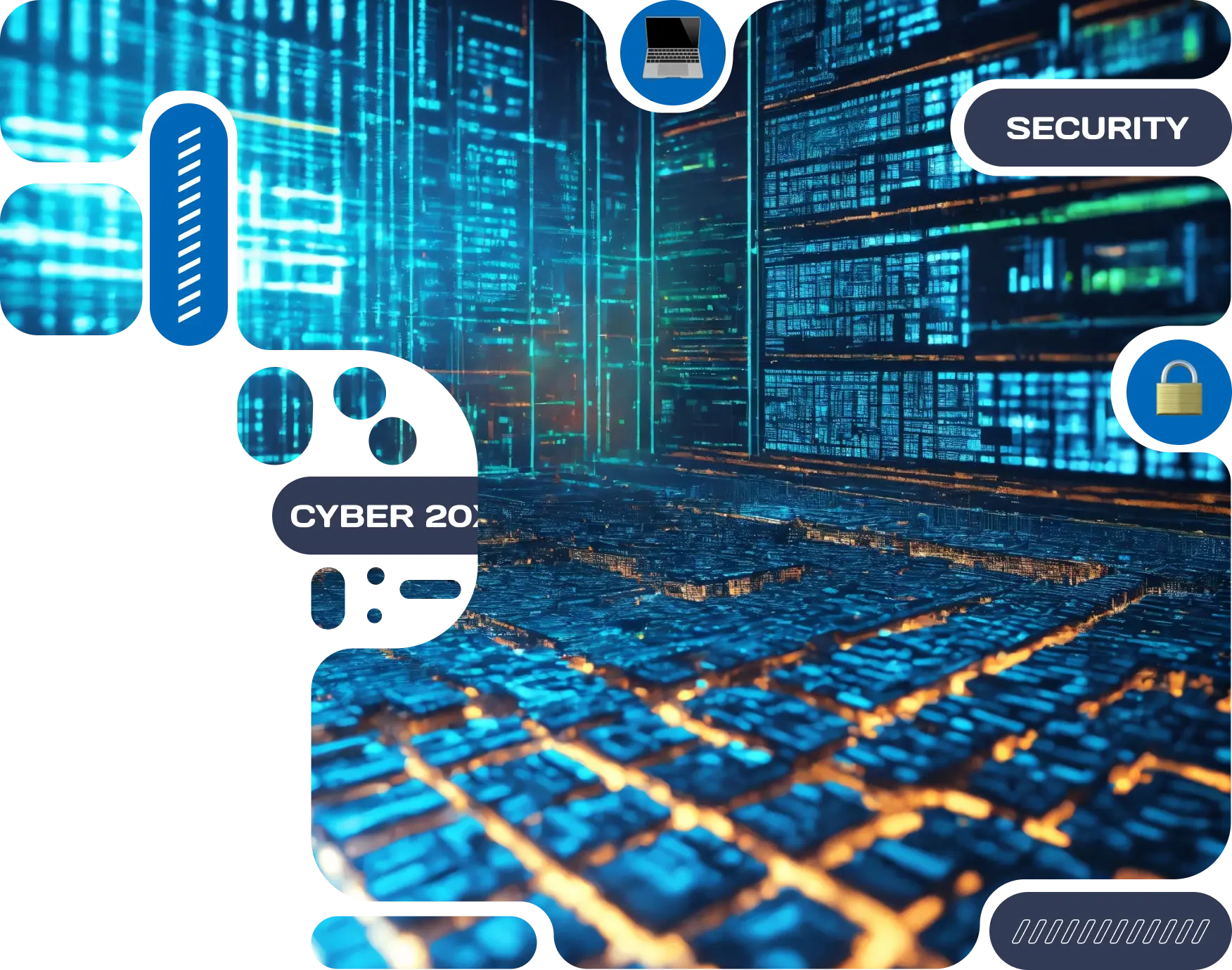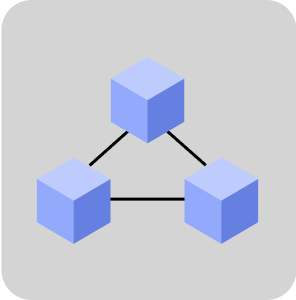Cybersecurity
Cyber savant
Security solutions
Cybersecurity services that protect the company from hack, malware and data breaches.

Special offer for you

Potential data breaches
Recognize potential breaches on your system.
Avoid code vulnerability
We look for Code Vulnerabilities for you.


30+
Unique services for new level of security.
Our services
///////
- Offensive
- Defensive
- Web3 Services
- Compliance
- Yellow Team

Penetration
Testing
Penetration testing as a service is a simulation of a hacker’s actions in order to identify vulnerabilities and assess the security of both external and internal information systems.

Google Cloud (GCP) Service
Empower your company’s cybersecurity with industry-leading practices. Our Company leverages advanced automation techniques and certified professionals to deliver actionable reports.

Azure Security
Audit
An Azure security audit involves assessing the security measures and controls implemented to safeguard an organization’s Azure environment. Its purpose is to detect vulnerabilities or risks within the environment.

OSINT / RECON
Service
OSINT/RECON is a defensive practice for safeguarding information assets. Intelligence gathering and analysis adhere to specific requirements and cybersecurity regulations.

Smart Contract
Audit
A smart contract, akin to traditional agreements, houses business logic, integrates with the blockchain, and executes specific actions upon meeting predefined conditions.

IOT Security
Audit
IOT Security Audit Service is a service aimed at auditing the security of Internet of Things (IoT) systems, including vulnerability assessment, risk evaluation, and recommendations for mitigation.

Social
Engineering
Social engineering manipulates people to access sensitive information or resources by exploiting human psychology, not technical means. It aims to trick individuals into revealing confidential data.

API Penetration
Testing
API penetration testing services safeguard your company’s digital assets through comprehensive security testing. With the rise in cyberattacks, ensuring protection against vulnerabilities is crucial.

Perfomance
Testing
Performance Testing evaluates system stability and performance metrics under heavy external loads. Our experts vary the load intensity to provide a comprehensive assessment.
Cybersecurity Investigation Service refers to a specialized service offered by cybersecurity firms or professionals to investigate and respond to cybersecurity incidents, breaches, or suspicious activities within an organization's digital environment. These services are crucial for identifying, containing, and mitigating the impact of cyber threats, as well as for gathering evidence for legal or regulatory purposes.
Here are some key components of Cybersecurity Investigation Services:
Incident Response: Rapidly responding to cybersecurity incidents, such as data breaches, malware infections, unauthorized access, or insider threats, to minimize damage and restore normal operations.
Forensic Analysis: Conducting thorough forensic analysis of digital systems, networks, and devices to identify the root cause of security incidents, preserve evidence, and establish a chain of custody for legal proceedings.
Malware Analysis: Analyzing malicious software (malware) to understand its functionality, propagation methods, and potential impact on affected systems.
Network Traffic Analysis: Monitoring and analyzing network traffic patterns to detect anomalous behavior, intrusions, or unauthorized access attempts.
Digital Evidence Collection: Collecting and preserving digital evidence in a forensically sound manner to support investigations, legal proceedings, or regulatory compliance requirements.
Threat Intelligence: Leveraging threat intelligence sources to identify and prioritize cybersecurity threats relevant to the organization's industry, geography, or technology stack.
Insider Threat Detection: Investigating suspicious activities or behaviors of employees, contractors, or other insiders to detect and mitigate insider threats to data security.
Incident Reporting and Documentation: Documenting findings, analysis, and remediation efforts in comprehensive incident reports for internal review, regulatory reporting, or law enforcement collaboration.
Post-Incident Recommendations: Providing recommendations and guidance to improve cybersecurity posture, enhance incident response capabilities, and prevent future security incidents.
Overall, Cybersecurity Investigation Services play a critical role in helping organizations effectively respond to and mitigate the impact of cyber threats, safeguarding their sensitive data, intellectual property, and reputation. These services often require a combination of technical expertise, industry knowledge, and compliance understanding to address the evolving landscape of cyber threats and regulatory requirements.
Cyber Supply Chain Risk Management (C-SCRM) refers to the process of identifying, assessing, and mitigating cybersecurity risks associated with the suppliers, vendors, and partners that contribute to an organization's supply chain. With the increasing interconnectedness of businesses and the reliance on third-party suppliers for various goods and services, cyber threats targeting the supply chain have become a significant concern for organizations across industries.
Key components of Cyber Supply Chain Risk Management include:
Supplier Risk Assessment: Evaluating the cybersecurity posture and practices of suppliers, vendors, and partners to assess their ability to protect sensitive information and systems from cyber threats.
Risk Identification: Identifying potential cybersecurity risks and vulnerabilities within the supply chain, including weaknesses in third-party products, services, or processes that could be exploited by threat actors.
Risk Quantification: Assessing the potential impact and likelihood of cyber risks affecting the supply chain, considering factors such as the criticality of the supplier's role, the sensitivity of the data or services involved, and the potential financial or reputational consequences of a security breach.
Risk Mitigation: Implementing measures to mitigate identified cyber risks within the supply chain, such as contractual obligations, security controls, vendor assessments, or contingency plans.
Continuous Monitoring: Monitoring the cybersecurity posture of suppliers and the overall supply chain ecosystem on an ongoing basis to detect emerging threats, vulnerabilities, or changes in risk exposure.
Incident Response and Recovery: Establishing protocols and procedures for responding to cybersecurity incidents or breaches affecting the supply chain, including communication with affected parties, containment of the incident, forensic analysis, and remediation efforts.
Compliance and Governance: Ensuring compliance with regulatory requirements, industry standards, and contractual obligations related to cybersecurity and supply chain risk management.
Collaboration and Information Sharing: Collaborating with suppliers, industry partners, and relevant stakeholders to share threat intelligence, best practices, and lessons learned in managing cyber supply chain risks.
By adopting a comprehensive Cyber Supply Chain Risk Management approach, organizations can better understand and mitigate the cybersecurity risks associated with their supply chain, enhance resilience to cyber threats, and safeguard the integrity, confidentiality, and availability of critical assets and operations.
Container Security Assessment refers to the process of evaluating the security posture of containers and containerized applications within a computing environment. Containers have become increasingly popular for deploying and managing applications due to their lightweight, portable nature and the ability to isolate applications and their dependencies. However, ensuring the security of containers is crucial to prevent vulnerabilities and protect sensitive data and resources from cyber threats.
Key aspects of Container Security Assessment include:
Image Scanning: Conducting vulnerability scans on container images to identify known security vulnerabilities or misconfigurations in the software packages and dependencies bundled within the container.
Configuration Analysis: Reviewing the configuration settings of container runtimes (e.g., Docker, Kubernetes) and orchestrators to ensure secure settings are applied, such as appropriate access controls, network segmentation, and resource isolation.
Runtime Monitoring: Implementing mechanisms for monitoring container runtime environments to detect anomalous behavior, unauthorized access attempts, or potential security breaches.
Access Control: Implementing strong authentication and authorization mechanisms to control access to containerized applications, APIs, and management interfaces.
Network Security: Implementing network segmentation, firewall rules, and encryption protocols to protect communications between containers, as well as between containers and external systems.
Logging and Auditing: Configuring logging and auditing mechanisms to capture relevant security events, container activities, and access attempts for forensic analysis and compliance purposes.
Compliance Checks: Ensuring compliance with regulatory requirements, industry standards, and organizational security policies governing container security and data protection.
Patch Management: Establishing processes for timely patching and updating of container images and underlying software components to address newly discovered vulnerabilities and security patches.
Incident Response: Developing incident response procedures and playbooks to guide response efforts in the event of a security incident or breach involving containerized environments.
Training and Awareness: Providing training and awareness programs for developers, DevOps teams, and system administrators on secure container development practices, security best practices, and threat mitigation techniques.
By conducting Container Security Assessments, organizations can identify and address security gaps, vulnerabilities, and misconfigurations within their containerized environments, thereby reducing the risk of security incidents, data breaches, and compliance violations.
Fuzz Testing, also known as Fuzzing or Fuzzing Testing, is a software testing technique used to discover vulnerabilities and defects by feeding unexpected, random, or malformed input data to a target application. The goal of fuzz testing is to identify potential security vulnerabilities, crashes, or unexpected behaviors that could be exploited by attackers or lead to software failures.
Here's how fuzz testing typically works:
Input Generation: Fuzz testing tools generate a large volume of random or semi-random input data to feed into the target application. This input data may include invalid, unexpected, or boundary values for input fields, file formats, network protocols, or API parameters.
Input Injection: The generated input data is injected into the target application through various entry points, such as user interfaces, file inputs, network connections, or API endpoints.
Monitoring and Analysis: The fuzzing tool monitors the behavior of the target application while processing the injected input data. It observes for any crashes, exceptions, memory leaks, unexpected responses, or other indicators of abnormal behavior.
Feedback and Mutation: Based on the observed behavior, the fuzzing tool may adjust the input generation strategy, mutating or modifying the input data to explore different paths and increase coverage. This iterative process continues until predefined testing criteria are met or a time limit is reached.
Reporting: Fuzz testing tools provide reports detailing the discovered vulnerabilities, crashes, or abnormal behaviors, along with information on how to reproduce the issues and potential impact on the security and stability of the software.
Fuzz testing can be applied at various stages of the software development lifecycle, including during development, integration testing, and security testing. It is particularly effective for uncovering memory corruption vulnerabilities, input validation flaws, buffer overflows, format string vulnerabilities, and other types of security weaknesses that may be difficult to identify through traditional testing methods.
Fuzz testing complements other security testing techniques, such as static analysis, dynamic analysis, and penetration testing, and helps organizations improve the overall security and reliability of their software applications.
Incident Response (IR) is a structured approach to addressing and managing the aftermath of a security breach or cyberattack. The primary goal of incident response is to minimize damage, contain the incident, and restore normal operations as quickly as possible. It involves a coordinated effort among various stakeholders, including IT professionals, security teams, executives, legal counsel, and communication experts.
Key components of incident response typically include:
Preparation: This phase involves establishing an incident response plan (IRP) outlining roles, responsibilities, and procedures for responding to security incidents. It may also include conducting risk assessments, identifying critical assets, and implementing preventive measures such as security controls and employee training.
Detection and Analysis: In this phase, security teams monitor networks, systems, and applications for signs of suspicious activity or security breaches. When an incident is detected, it is analyzed to determine the nature and scope of the attack, including the techniques used by the attacker and the impact on affected systems and data.
Containment: Once an incident is confirmed, the next step is to contain the threat to prevent further damage or unauthorized access. This may involve isolating affected systems, blocking malicious traffic, revoking compromised credentials, or shutting down compromised services.
Eradication: In this phase, security teams work to remove the root cause of the incident and eliminate any malware, backdoors, or other malicious artifacts from affected systems. This may require restoring systems from backups, applying security patches, or reconfiguring security settings.
Recovery: After the threat has been neutralized, efforts are focused on restoring affected systems and data to a secure and operational state. This may involve rebuilding systems, restoring data from backups, and implementing additional security measures to prevent similar incidents in the future.
Post-Incident Analysis: Following the resolution of the incident, a thorough review is conducted to assess the effectiveness of the incident response process and identify lessons learned. This may involve documenting the incident, analyzing response actions, and updating incident response plans and security controls based on the findings.
Effective incident response requires close coordination between technical teams, management, legal counsel, and other stakeholders. It also requires clear communication both internally and externally, particularly with customers, partners, regulatory authorities, and the public, depending on the nature and severity of the incident.
Cybersecurity Risk Assessment is the process of identifying, analyzing, and evaluating potential threats, vulnerabilities, and their impacts on an organization's information systems, data, and resources. The objective of Risk Assessment is to determine the level of risk and develop a risk management strategy aimed at reducing the likelihood of threats and minimizing their impact on business processes and operations.
Key steps in Cybersecurity Risk Assessment include:
Asset Identification: Identifying all information assets, including data, applications, systems, networks, and other resources that may be subject to threats and risks.
Threat and Vulnerability Identification: Analyzing existing and potential threats that may affect the security of information assets, as well as identifying vulnerabilities that could be exploited by attackers.
Probability and Impact Assessment: Assessing the likelihood of threats occurring and their potential impact on information assets and organizational operations, as well as identifying potential consequences in the event of a security breach.
Risk Level Evaluation: Assessing the overall risk level based on the analysis of threat probability, potential impact, and the effectiveness of existing controls and security measures.
Risk Management Strategy Development: Developing an action plan for risk management, including selecting and implementing appropriate controls, risk treatment decisions (e.g., risk transfer, mitigation, avoidance), and prioritizing activities to enhance security.
Monitoring and Updating: Continuously monitoring threats and vulnerabilities, as well as updating risk assessments based on changes in the threat landscape, technological advancements, and changes in organizational processes.
Cybersecurity Risk Assessment is a critical component of an effective risk management strategy and helps organizations make informed decisions about allocating resources to security and protecting their information assets.
A white box pentest, also known as a transparent or internal pentest, is a type of cybersecurity assessment in which the tester has complete knowledge and access to the system being tested. This can include access to source code, configuration files, internal network infrastructure, design documents, and other implementation details.
During white box testing, we focus on the internal structure of the system and try to identify defects and vulnerabilities by examining the code and design of the system. We use various techniques, such as code review, testing the logic of individual functions and modules, and testing the system’s internal data structures.
The Security Operations Center (SOC) is an integrated system that monitors an organization’s entire IT infrastructure in real time, 24/7, for cyber network security with all the information that is continuously processed by computer systems.
Our SOC team, by monitoring and analyzing cyber threats, instantly detects cybersecurity incidents for the fastest and most effective resolution, preventing possible risks and hacks. So, SOC as a service generally improves the security of the entire infrastructure.
A Network Operations Center (NOC) Service is a centralized facility or team responsible for monitoring, managing, and maintaining an organization's network infrastructure and services. The primary role of a NOC is to ensure the availability, performance, and security of the network, as well as to respond to incidents and resolve issues in a timely manner.
Key functions of a Network Operations Center (NOC) Service include:
Monitoring: Continuous monitoring of network devices, systems, and services using network management tools and software to detect anomalies, performance degradation, and security threats.
Alerting and Incident Response: Prompt identification and response to network incidents, alarms, and alerts, including troubleshooting, diagnosis, and resolution of issues to minimize downtime and service disruptions.
Performance Management: Monitoring and optimizing network performance, bandwidth utilization, and service levels to ensure efficient and reliable operation of network services.
Configuration Management: Managing network configurations, updates, and changes to ensure consistency, compliance with standards, and security best practices.
Capacity Planning: Forecasting future network capacity requirements based on usage trends, growth projections, and business needs, and implementing strategies to scale network resources accordingly.
Security Monitoring: Monitoring network traffic for signs of unauthorized access, malware, intrusions, and other security threats, and implementing security controls and countermeasures to protect against attacks.
Incident Tracking and Reporting: Documenting and tracking network incidents, service requests, and resolutions, as well as generating reports and performance metrics for management, compliance, and analysis purposes.
Collaboration and Communication: Collaborating with other IT teams, vendors, and stakeholders to coordinate network changes, upgrades, and maintenance activities, as well as communicating with end-users about service outages and maintenance windows.
A Network Operations Center (NOC) Service plays a crucial role in ensuring the reliability, availability, and security of an organization's network infrastructure, supporting business operations, and minimizing the impact of network-related issues on productivity and customer satisfaction.
Computer Forensics Service involves the investigation and analysis of digital devices and data to gather evidence for legal or investigative purposes. This service utilizes specialized techniques and tools to extract, preserve, and analyze digital evidence from computers, mobile devices, storage media, and networks. The goal is to uncover and document information related to cybercrimes, security breaches, data breaches, intellectual property theft, and other digital incidents. Computer forensics services are often employed in legal proceedings, criminal investigations, incident response, and internal investigations conducted by organizations.

Cosmos Smart Contract Audit
Cosmos Smart Contract Audit service ensures the security and reliability of your projects on the Cosmos network.

Solana Smart Contract Audit
Solana Smart Contract Audit service ensures the security and resilience of your Solana-based projects.

DApp Security Audit Service
Unlock the potential of your decentralized application (DApp) while ensuring its impregnable security.

Near Smart Contract Audit
Near Smart Contract Audit service ensures the security and resilience of your Near-based projects.

Polygon Smart Contract Audit
Polygon Smart Contract Audit service prioritizes the security and robustness of your Polygon-based projects.

Binance Smart Chain (BSC) Smart Contract Audit
Binance Smart Chain (BSC) Audit service ensures the security and reliability of your BSC projects.

Blockchain Security Audit Service
In a landscape where security is paramount, our Blockchain Security Audit Service guarantees enhanced protection.

Web3 Penetration Testing Service
Take control of your company’s cybersecurity with best practices.

Ethereum (EVM) Smart Contract Audit Service
Ethereum (EVM) Smart Contract Audit Services prioritize the security and reliability of your Ethereum-based projects.
SOC 2 (Service Organization Control 2) is a widely recognized compliance framework developed by the American Institute of CPAs (AICPA) to assess the security, availability, processing integrity, confidentiality, and privacy of systems and data within service organizations. Achieving SOC 2 compliance demonstrates your commitment to safeguarding client data and maintaining the highest standards of operational excellence
HIPAA compliance is not just a legal obligation; it’s a critical step toward protecting patient privacy and data integrity. Non-compliance can result in severe penalties, loss of reputation, and compromised patient trust. Our team of experienced cybersecurity professionals understands the intricacies of HIPAA regulations and empowers your organization to establish a robust security framework that mitigates risks and safeguards sensitive information.
The Payment Card Industry Data Security Standard (PCI DSS) serves as a crucial framework for organizations that handle payment card information. Achieving PCI DSS compliance not only safeguards your customers’ trust but also protects your business from potential data breaches and financial penalties.
In today’s hyper-connected world, protecting your digital assets is paramount. ISO 27001 is an internationally recognized standard that sets the gold standard for information security management systems (ISMS). Achieving ISO 27001 certification demonstrates your dedication to preserving the confidentiality, integrity, and availability of your data, reassuring your stakeholders and clients that their information is in safe hands.
GDPR (General Data Protection Regulation) Compliance Service refers to a suite of services offered by various companies to help businesses ensure that they comply with the regulations set forth by the GDPR. The GDPR is a comprehensive data protection law enacted by the European Union (EU) to protect the personal data and privacy of EU citizens, as well as regulate the transfer of personal data outside the EU and European Economic Area (EEA).
GDPR Compliance Services typically include:
Data Audit and Assessment: Assessing the current data processing practices and identifying areas where changes are needed to comply with GDPR requirements.
Data Protection Officer (DPO) Services: Providing access to experts who can act as Data Protection Officers or offer guidance on DPO responsibilities as required by the GDPR.
Data Mapping and Inventory: Identifying and documenting all personal data processed by the organization, including its sources, storage locations, and lawful bases for processing.
Privacy Policy and Documentation: Helping to draft and update privacy policies, notices, and other documentation required by the GDPR.
Training and Awareness: Conducting training sessions to educate employees about GDPR requirements and best practices for data protection.
Consent Management: Implementing mechanisms for obtaining, managing, and documenting user consent for data processing activities.
Data Subject Rights Management: Establishing procedures for handling data subject requests, such as access requests, rectification, erasure, and data portability.
Data Breach Response: Developing protocols for detecting, investigating, and reporting data breaches in accordance with GDPR requirements.
Compliance Monitoring and Reporting: Regularly monitoring compliance with GDPR requirements and providing reports to management or regulatory authorities as necessary.
Overall, GDPR Compliance Services aim to assist organizations in meeting their legal obligations under the GDPR, reducing the risk of fines and penalties for non-compliance, and enhancing trust and transparency in data processing practices.
Our specialists are ISO 21434 compliance experts, guiding automotive companies through the complexities of this standard. From risk assessment to cybersecurity implementation, we provide tailored solutions to ensure adherence to the highest cybersecurity standards.
We conduct risk assessments, develop cybersecurity strategies, implement controls, and monitor compliance. Partner with us to address vulnerabilities and secure your automotive systems effectively.
Take proactive steps to adopt ISO 21434 compliance to improve your standing, foster trust, and protect your brand. The professionals we employ recognize hazards, put in place safeguards, and create incident response strategies. Reduce risks before they have an impact on your organization, customers, or goods.
Compliance and Governance Technology is your business’s internal control and risk management system to ensure compliance with legal, ethical and corporate standards.
Compliance solutions help you ensure that meeting the requirements and standards that apply to your industry.
Avoid financial sanctions and reputational losses with CryEye Compliance and Governance experts modeling, managing and eliminating potential company risks.
A Cyber Security Gap Assessment is a structured evaluation of an organization's existing cybersecurity measures, policies, procedures, and controls to identify gaps or deficiencies in its security posture. The assessment aims to pinpoint areas where the organization's security practices fall short of industry standards, regulatory requirements, or best practices, and to provide recommendations for improvement.
Key components of a Cyber Security Gap Assessment typically include:
Policy and Procedure Review: Evaluating existing cybersecurity policies, procedures, and guidelines to ensure they are comprehensive, up-to-date, and aligned with industry standards and regulatory requirements.
Security Controls Assessment: Assessing the effectiveness of security controls implemented by the organization, such as firewalls, intrusion detection systems, antivirus software, access controls, encryption, and monitoring tools.
Risk Management Evaluation: Reviewing the organization's risk management processes and practices to identify gaps in risk assessment, risk mitigation, and risk monitoring activities.
Incident Response Readiness: Assessing the organization's incident response capabilities, including incident detection, response procedures, incident handling, and post-incident analysis.
Security Awareness and Training: Evaluating the organization's security awareness training programs for employees to ensure they are effective in educating staff about cybersecurity best practices, policies, and procedures.
Vendor and Third-Party Risk Assessment: Assessing the security posture of vendors, suppliers, and third-party service providers that have access to the organization's systems, data, or networks.
Compliance and Regulatory Compliance: Reviewing the organization's compliance with relevant cybersecurity regulations, standards, and frameworks, such as GDPR, HIPAA, PCI DSS, ISO 27001, NIST Cybersecurity Framework, etc.
Gap Analysis and Remediation Recommendations: Analyzing the findings from the assessment to identify gaps, weaknesses, and areas for improvement in the organization's cybersecurity posture. Providing recommendations and prioritized action plans to address identified gaps and enhance the organization's overall security resilience.
By conducting a Cyber Security Gap Assessment, organizations can gain valuable insights into their cybersecurity strengths and weaknesses, prioritize security investments and initiatives, and improve their ability to prevent, detect, and respond to cyber threats effectively.
Due Diligence Service refers to a thorough investigation or examination of a business, individual, or transaction to assess its viability, risks, and compliance with legal, financial, and regulatory requirements. The goal of due diligence is to gather comprehensive information and insights to enable informed decision-making, risk mitigation, and protection of interests.
Key aspects of Due Diligence Service typically include:
Financial Due Diligence: Reviewing financial statements, tax records, cash flows, assets, liabilities, and other financial data to assess the financial health and stability of a business or investment opportunity.
Legal Due Diligence: Evaluating legal documentation, contracts, licenses, permits, regulatory filings, and litigation history to identify legal risks, compliance issues, and potential liabilities.
Operational Due Diligence: Assessing operational processes, infrastructure, supply chain, technology systems, and management practices to identify operational risks, inefficiencies, and areas for improvement.
Compliance Due Diligence: Verifying compliance with regulatory requirements, industry standards, and best practices relevant to the business or transaction, such as anti-money laundering (AML), know your customer (KYC), data protection, and environmental regulations.
Strategic Due Diligence: Analyzing market trends, competitive landscape, industry dynamics, growth prospects, and strategic fit to assess the strategic rationale and potential synergies of a business or investment opportunity.
Cybersecurity Due Diligence: Assessing the cybersecurity posture, data security practices, IT infrastructure, and cyber risk exposure of a business or investment target to identify potential security vulnerabilities and threats.
Environmental Due Diligence: Evaluating environmental risks, compliance with environmental regulations, pollution liabilities, and potential environmental impacts associated with a business, property, or investment.
Intellectual Property Due Diligence: Reviewing intellectual property (IP) assets, patents, trademarks, copyrights, and licensing agreements to assess the value, ownership, and potential risks associated with intellectual property rights.
By conducting Due Diligence Service, organizations can make well-informed decisions, mitigate risks, negotiate better terms, and protect themselves from potential legal, financial, and reputational consequences associated with business transactions, investments, partnerships, or acquisitions. Due diligence is a critical step in the decision-making process for businesses, investors, lenders, and other stakeholders to ensure transparency, accountability, and risk management.
Cybersecurity Research Service involves conducting in-depth analysis and investigation into various aspects of cybersecurity to uncover new threats, vulnerabilities, attack techniques, defense strategies, and emerging trends. This service encompasses a wide range of activities, including data collection, data analysis, experimentation, testing, and dissemination of research findings to the cybersecurity community.
Key components of Cybersecurity Research Service include:
Threat Intelligence Research: Collecting, analyzing, and disseminating information about cyber threats, including malware, vulnerabilities, exploits, and tactics, techniques, and procedures (TTPs) used by threat actors.
Vulnerability Research: Identifying and analyzing software vulnerabilities in applications, operating systems, and network protocols, and developing proof-of-concept exploits or mitigations to address them.
Attack Surface Analysis: Investigating the attack surface of systems, networks, and applications to identify potential entry points, misconfigurations, or weaknesses that could be exploited by attackers.
Malware Analysis: Reverse-engineering and analyzing malware samples to understand their behavior, functionality, and impact on systems and networks, and developing detection and mitigation techniques.
Security Architecture Research: Studying and evaluating security architectures, protocols, and cryptographic algorithms to identify weaknesses, design flaws, or potential improvements for enhancing security.
Security Testing and Evaluation: Conducting security assessments, penetration tests, and red team exercises to evaluate the effectiveness of security controls, policies, and procedures in protecting systems and data.
Emerging Technology Assessment: Investigating emerging technologies, such as Internet of Things (IoT), cloud computing, artificial intelligence (AI), and blockchain, to assess their security implications and develop best practices for their secure deployment.
Policy and Regulatory Research: Studying cybersecurity regulations, standards, and best practices to provide guidance on compliance requirements and help organizations align with legal and regulatory frameworks.
Cybersecurity Research Service plays a crucial role in advancing the field of cybersecurity, improving security practices, and enhancing the resilience of organizations against evolving cyber threats. By staying abreast of the latest research developments and sharing knowledge and insights with the cybersecurity community, research services contribute to the collective effort to strengthen cybersecurity defenses and protect digital assets and infrastructure.
As of my last update in January 2022, "CSAS" does not correspond to any widely recognized cybersecurity certification or standard. It's possible that it may refer to a specific certification, framework, or standard that has emerged after my last update. If "CSAS" stands for a particular certification, it would be helpful to know the full name or acronym expansion to provide more accurate information about it. If you have any additional context or details about the "CSAS" certification you're referring to, please provide them so I can assist you better.
DevSecOps is a methodology that integrates security practices and principles into the DevOps (Development and Operations) process. It emphasizes a shift-left approach to security, where security considerations are incorporated early and continuously throughout the software development lifecycle (SDLC). The goal of DevSecOps is to foster collaboration between development, operations, and security teams to build secure, resilient, and compliant software applications.
Key principles and practices of DevSecOps include:
Automation: Automating security testing, compliance checks, and configuration management processes to detect and remediate security issues early in the development pipeline.
Continuous Integration and Continuous Deployment (CI/CD): Integrating security testing and validation into CI/CD pipelines to ensure that security checks are performed automatically with each code change and deployment.
Security as Code: Treating security policies, configurations, and controls as code artifacts that can be versioned, tested, and deployed alongside application code.
Shift-Left Security: Incorporating security practices and controls as early as possible in the development process, starting from design and development stages.
Threat Modeling: Conducting threat modeling exercises to identify and prioritize potential security threats and vulnerabilities early in the development process.
Container Security: Implementing security controls and best practices for securing containerized applications and microservices deployed in container orchestration platforms like Kubernetes.
Infrastructure as Code (IaC): Managing infrastructure configurations and provisioning using code-based tools to enforce security standards and best practices.
Security Testing: Performing various security tests, such as static application security testing (SAST), dynamic application security testing (DAST), and software composition analysis (SCA), as part of the CI/CD pipeline to identify and remediate security vulnerabilities.
Collaboration and Culture: Fostering a culture of shared responsibility and collaboration between development, operations, and security teams, encouraging open communication and knowledge sharing.
By embracing DevSecOps principles and practices, organizations can accelerate software delivery, improve agility, and enhance security posture by integrating security into every stage of the software development lifecycle. This approach helps organizations effectively manage security risks, comply with regulatory requirements, and build trust with customers and stakeholders.
Reverse Engineering is the process of analyzing a product, system, or software to understand its design, functionality, and operation, often with the goal of reproducing or modifying it. In the context of software, reverse engineering involves examining compiled code, binaries, or firmware to extract high-level information, such as algorithms, data structures, and logic, from lower-level representations.
Key aspects of Reverse Engineering include:
Decompilation: Converting machine-executable code (e.g., machine code, bytecode) back into a higher-level programming language (e.g., C, Java) or assembly language to understand its logic and behavior.
Code Analysis: Examining the structure, functions, and flow of the code to identify patterns, algorithms, and dependencies.
Static Analysis: Analyzing the software without executing it, often through examining code, binaries, or configuration files, to identify vulnerabilities, understand functionality, and extract information.
Dynamic Analysis: Running the software in a controlled environment and observing its behavior to understand its runtime characteristics, interactions, and dependencies.
Reverse Engineering Tools: Using specialized tools and techniques, such as disassemblers, decompilers, debuggers, and memory analyzers, to aid in the reverse engineering process.
Legal and Ethical Considerations: Adhering to legal and ethical guidelines when reverse engineering proprietary software or systems, ensuring compliance with intellectual property laws and agreements.
Reverse Engineering is commonly used in various domains, including software security, malware analysis, software interoperability, legacy system migration, and competitive analysis. It enables researchers, developers, and analysts to gain insights into complex systems, uncover vulnerabilities, and improve understanding of how software and systems work. However, it's essential to conduct reverse engineering activities ethically and in compliance with relevant laws and regulations.

Our vision
Cybersecurity Savant, the paramount expert in cybersecurity. With profound comprehension of digital threats and extensive experience, we stand at the forefront of safeguarding data and systems from adversarial attacks.
Our vision is to create a secure cyberspace where every company can thrive safely. We are not just analysts and technicians; we are guardians of your trust, defenders of your digital realm.
Entrust us with your security, and we will provide you with the utmost protection.
Our services
///////
Secured Companies
Years On Market
Projects
Repulsed Attacks
social media subscriptions
regular customers
Latest post

blog
hack
What Is Smart Contract Audit and Why Is It Essential for Ensuring the Security
certifications
get in touch!
Get a quote and we will contact you shortly
Our media
Our contacts

